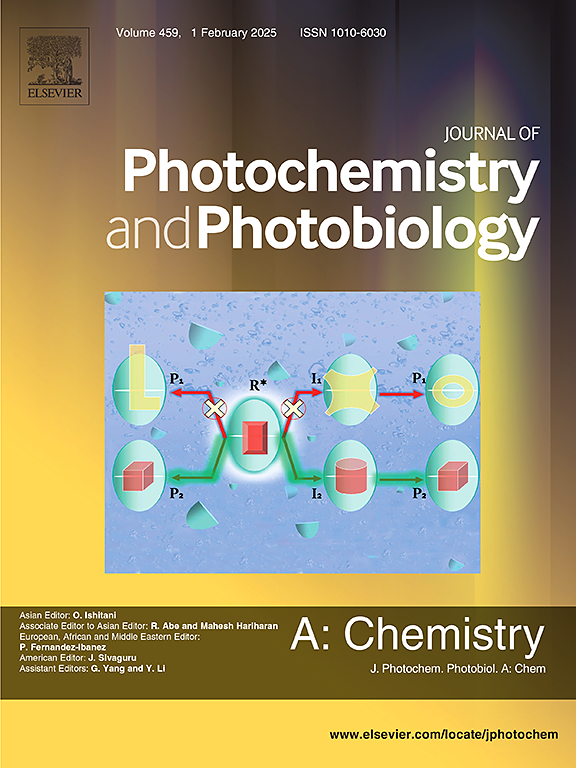揭示了swcnts作为TiO2掺杂剂在医药混合物光催化脱除水中和废水中的作用
IF 4.1
3区 化学
Q2 CHEMISTRY, PHYSICAL
Journal of Photochemistry and Photobiology A-chemistry
Pub Date : 2025-04-07
DOI:10.1016/j.jphotochem.2025.116437
引用次数: 0
摘要
药品和个人护理产品使用的增加增加了它们的处置。生物降解性低,常规处理去除效果差,远距离迁移使其成为持久性污染物。清除这些污染物现在非常重要,需要先进的技术。利用可见光进行光催化是一种很有前途的水和废水解毒方法。在本研究中,测试了单壁碳纳米管(SWCNT)对TiO2-SiO2活性的影响。该催化剂具有较高的有效表面积(280 ~ 525 m2 g−1)和较低的带隙能(2.84 ~ 3.03 eV),表明其具有良好的可见光催化性能。广泛的光催化特性表明,当swcnts掺杂量在1.7-3.5 wt%之间时,光催化剂的性能变化最大。K1值从0.0038 min−1(布洛芬)、0.0204 min−1(卡马西平)、0.0626 min−1(奥司他韦)到0.0783 min−1(美托洛尔)不等。估计了无机离子、溶解有机物和离子强度的影响。采用自由基清除剂研究了该工艺的机理,并以自来水和处理后的废水为原料进行了实验研究。结果证实,获得的材料具有增强的表面积和孔隙率,丰富的表面官能团,以及可见光活化,应该显示出巨大的污染物去除潜力。本文章由计算机程序翻译,如有差异,请以英文原文为准。

Unveiling the effect of SWCNT as the dopants of TiO2 in pharmaceutical mixture photocatalytic removal from water and wastewater
Increased pharmaceuticals and personal care products usage increases their disposal. Low biodegradability, poor removal during conventional treatment, and long-range transport make them persistent pollutants. Removal of such pollutants is of great importance nowadays and requires advanced techniques. Photocatalysis using visible light is a promising method for detoxifying water and wastewater. In the presented studies the effect of Single-Walled Carbon Nanotubes (SWCNT) on the activity of TiO2-SiO2 was tested. The photocatalysts were characterized by high available surface area (280–525 m2 g−1), and reduced band gap energy (2.84–3.03 eV) suggesting good photocatalytic behavior under vis irradiation. The broad characteristics of the photocatalysis revealed that the greatest changes in the photocatalysts’ properties were noted when the amount of doped SWCNT was between 1.7–3.5 wt%. k1 values ranged from 0.0038 min−1 (ibuprofen), 0.0204 min−1 (carbamazepine), 0.0626 min−1 (oseltamivir), to 0.0783 min−1 (metoprolol). The effect of inorganic ions, dissolved organic matter, and ionic strength were estimated. The process mechanism was examined using radical scavengers and the process was performed using tap water and treated wastewater. The results confirmed that obtained materials with enhanced surface area and porosity, abundance of surface functional groups, and visible light activation should reveal a great potential for pollutant removal.
求助全文
通过发布文献求助,成功后即可免费获取论文全文。
去求助
来源期刊
CiteScore
7.90
自引率
7.00%
发文量
580
审稿时长
48 days
期刊介绍:
JPPA publishes the results of fundamental studies on all aspects of chemical phenomena induced by interactions between light and molecules/matter of all kinds.
All systems capable of being described at the molecular or integrated multimolecular level are appropriate for the journal. This includes all molecular chemical species as well as biomolecular, supramolecular, polymer and other macromolecular systems, as well as solid state photochemistry. In addition, the journal publishes studies of semiconductor and other photoactive organic and inorganic materials, photocatalysis (organic, inorganic, supramolecular and superconductor).
The scope includes condensed and gas phase photochemistry, as well as synchrotron radiation chemistry. A broad range of processes and techniques in photochemistry are covered such as light induced energy, electron and proton transfer; nonlinear photochemical behavior; mechanistic investigation of photochemical reactions and identification of the products of photochemical reactions; quantum yield determinations and measurements of rate constants for primary and secondary photochemical processes; steady-state and time-resolved emission, ultrafast spectroscopic methods, single molecule spectroscopy, time resolved X-ray diffraction, luminescence microscopy, and scattering spectroscopy applied to photochemistry. Papers in emerging and applied areas such as luminescent sensors, electroluminescence, solar energy conversion, atmospheric photochemistry, environmental remediation, and related photocatalytic chemistry are also welcome.

 求助内容:
求助内容: 应助结果提醒方式:
应助结果提醒方式:


